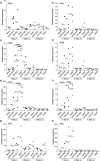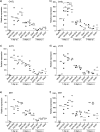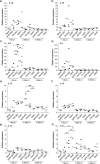IFN and cytokine responses in ducks to genetically similar H5N1 influenza A viruses of varying pathogenicity
- PMID: 29458524
- PMCID: PMC6537622
- DOI: 10.1099/jgv.0.001015
IFN and cytokine responses in ducks to genetically similar H5N1 influenza A viruses of varying pathogenicity
Abstract
Ducks, the reservoir host, are generally permissive to influenza A virus infection without disease symptoms. This natural ecology was upset by the emergence of H5N1 strains, which can kill ducks. To better understand host-virus interactions in the reservoir host, and influenza strain-specific molecular contributions to virulence, we infected White Pekin ducks with three similar H5N1 viruses, with known differences in pathogenicity and replication rate. We quantified viral replication and innate immune gene activation by qPCR, in lung and spleen tissues, isolated on each of the first 3 days of infection. The three viruses replicated well, as measured by accumulation of matrix gene transcript, and viral load declined over time in the spleen. The ducks produced rapid, but temporally limited, IFN and cytokine responses, peaking on the first day post-infection. IFN and proinflammatory cytokine gene induction were greater in response to infection with the more lethal viruses, compared to an attenuated strain. We conclude that a well-regulated IFN response, with the ability to overcome early viral immune inhibition, without hyperinflammation, contributes to the ability of ducks to survive H5N1 influenza replication in their airways, and yet clear systemic infection and limit disease.
Keywords: H5N1; cytokine; duck; inflammation; influenza A; interferon.
Conflict of interest statement
The authors declare that there are no conflicts of interest.
Figures





Similar articles
-
Duck innate immune responses to high and low pathogenicity H5 avian influenza viruses.Vet Microbiol. 2019 Jan;228:101-111. doi: 10.1016/j.vetmic.2018.11.018. Epub 2018 Nov 19. Vet Microbiol. 2019. PMID: 30593354 Free PMC article.
-
Host immune responses of ducks infected with H5N1 highly pathogenic avian influenza viruses of different pathogenicities.Vet Microbiol. 2013 Oct 25;166(3-4):386-93. doi: 10.1016/j.vetmic.2013.06.019. Epub 2013 Jul 9. Vet Microbiol. 2013. PMID: 23920409
-
Highly pathogenic avian influenza virus infection in chickens but not ducks is associated with elevated host immune and pro-inflammatory responses.Vet Res. 2014 Nov 28;45(1):118. doi: 10.1186/s13567-014-0118-3. Vet Res. 2014. PMID: 25431115 Free PMC article.
-
[Cytokine storm in avian influenza].Mikrobiyol Bul. 2008 Apr;42(2):365-80. Mikrobiyol Bul. 2008. PMID: 18697437 Review. Turkish.
-
Pattern Recognition Receptor Signaling and Innate Responses to Influenza A Viruses in the Mallard Duck, Compared to Humans and Chickens.Front Cell Infect Microbiol. 2020 May 12;10:209. doi: 10.3389/fcimb.2020.00209. eCollection 2020. Front Cell Infect Microbiol. 2020. PMID: 32477965 Free PMC article. Review.
Cited by
-
Duck innate immune responses to high and low pathogenicity H5 avian influenza viruses.Vet Microbiol. 2019 Jan;228:101-111. doi: 10.1016/j.vetmic.2018.11.018. Epub 2018 Nov 19. Vet Microbiol. 2019. PMID: 30593354 Free PMC article.
-
The Microbiota Contributes to the Control of Highly Pathogenic H5N9 Influenza Virus Replication in Ducks.J Virol. 2020 May 4;94(10):e00289-20. doi: 10.1128/JVI.00289-20. Print 2020 May 4. J Virol. 2020. PMID: 32102887 Free PMC article.
-
Knock-in of the duck retinoic acid-inducible gene I (RIG-I) into the Mx gene in DF-1 cells enables both stable and immune response-dependent RIG-I expression.Biochem Biophys Rep. 2021 Jul 26;27:101084. doi: 10.1016/j.bbrep.2021.101084. eCollection 2021 Sep. Biochem Biophys Rep. 2021. PMID: 34381879 Free PMC article.
-
Role of tumor necrosis factor-α in the mortality of hospitalized patients with severe and critical COVID-19 pneumonia.Aging (Albany NY). 2021 Nov 1;13(21):23895-23912. doi: 10.18632/aging.203663. Epub 2021 Nov 1. Aging (Albany NY). 2021. PMID: 34725309 Free PMC article.
-
The role of interleukin-6 in monitoring severe case of coronavirus disease 2019.EMBO Mol Med. 2020 Jul 7;12(7):e12421. doi: 10.15252/emmm.202012421. Epub 2020 Jun 5. EMBO Mol Med. 2020. PMID: 32428990 Free PMC article.
References
Publication types
MeSH terms
Substances
Grants and funding
LinkOut - more resources
Full Text Sources
Other Literature Sources
Medical

